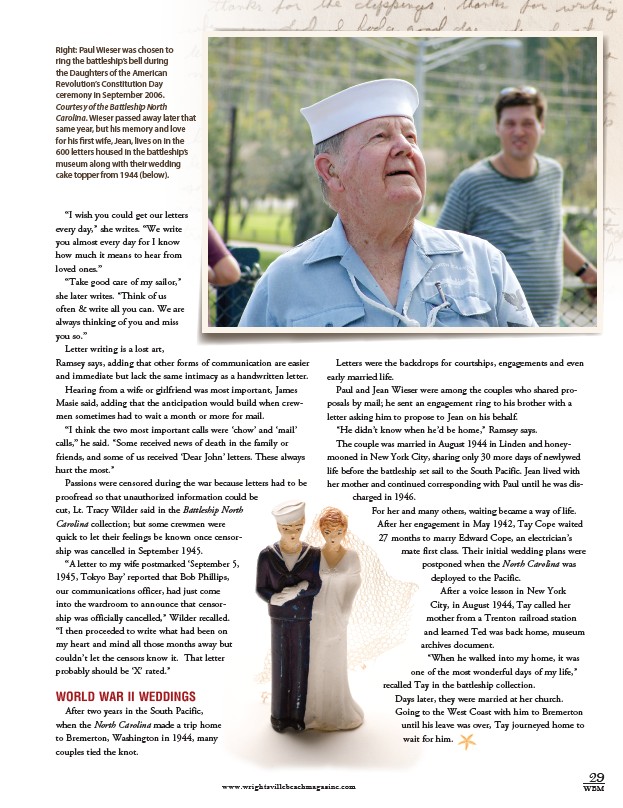
29
“I wish you could get our letters
every day,” she writes. “We write
you almost every day for I know
how much it means to hear from
loved ones.”
“Take good care of my sailor,”
she later writes. “Think of us
often & write all you can. We are
always thinking of you and miss
you so.”
Letter writing is a lost art,
Ramsey says, adding that other forms of communication are easier
and immediate but lack the same intimacy as a handwritten letter.
Hearing from a wife or girlfriend was most important, James
Masie said, adding that the anticipation would build when crew-men
sometimes had to wait a month or more for mail.
“I think the two most important calls were ‘chow’ and ‘mail’
calls,” he said. “Some received news of death in the family or
friends, and some of us received ‘Dear John’ letters. These always
hurt the most.”
Passions were censored during the war because letters had to be
proofread so that unauthorized information could be
cut, Lt. Tracy Wilder said in the Battleship North
Carolina collection; but some crewmen were
quick to let their feelings be known once censor-ship
was cancelled in September 1945.
“A letter to my wife postmarked ‘September 5,
1945, Tokyo Bay’ reported that Bob Phillips,
our communications officer, had just come
into the wardroom to announce that censor-ship
was officially cancelled,” Wilder recalled.
“I then proceeded to write what had been on
my heart and mind all those months away but
couldn’t let the censors know it. That letter
probably should be ‘X’ rated.”
World War I weddings
After two years in the South Pacific,
when the North Carolina made a trip home
to Bremerton, Washington in 1944, many
couples tied the knot.
Letters were the backdrops for courtships, engagements and even
early married life.
Paul and Jean Wieser were among the couples who shared pro-posals
by mail; he sent an engagement ring to his brother with a
letter asking him to propose to Jean on his behalf.
“He didn’t know when he’d be home,” Ramsey says.
The couple was married in August 1944 in Linden and honey-mooned
in New York City, sharing only 30 more days of newlywed
life before the battleship set sail to the South Pacific. Jean lived with
her mother and continued corresponding with Paul until he was dis-charged
in 1946.
For her and many others, waiting became a way of life.
After her engagement in May 1942, Tay Cope waited
27 months to marry Edward Cope, an electrician’s
mate first class. Their initial wedding plans were
postponed when the North Carolina was
deployed to the Pacific.
After a voice lesson in New York
City, in August 1944, Tay called her
mother from a Trenton railroad station
and learned Ted was back home, museum
archives document.
“When he walked into my home, it was
one of the most wonderful days of my life,”
recalled Tay in the battleship collection.
Days later, they were married at her church.
Going to the West Coast with him to Bremerton
until his leave was over, Tay journeyed home to
wait for him.
www.wrightsvillebeachmagazine.com WBM
Right: Paul Wieser was chosen to
ring the battleship’s bell during
the Daughters of the American
Revolution’s Constitution Day
ceremony in September 2006.
Courtesy of the Battleship North
Carolina. Wieser passed away later that
same year, but his memory and love
for his first wife, Jean, lives on in the
600 letters housed in the battleship’s
museum along with their wedding
cake topper from 1944 (below).